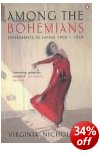unconventional ways of living: 1900-1940
For almost half a lifetime I have marvelled at the way Bloomsbury bohemians organised their private lives. Switching partners, even sexes in their life choices? They took it in their stride. Menage a trois? Easy-peasy. Menage a quatre? Can be done. How on earth did they manage it? Virginia Nicholson’s Among the Bohemians is largely an answer to that question. She looks in detail at the way bohemian English people (largely artists and writers) organised their lives in what we would now call an ‘alternative’ manner and went out of their way to live La Vie Boheme.
 It’s an enormously entertaining book, packed with anecdotes on every page and written by the daughter of Quentin Bell, who was the son of Vanessa Bell, who in her turn was Virginia Woolf’s sister. This is a very telling provenance. She deals fairly comprehensively with her relatives and friends from the Bloomsbury Group about whom we already know a great deal, but the other figures who feature strongly are Augustus John, Eric Gill, Dylan Thomas, Robert Graves, plus minor figures such as Nina Hamnett, Betty May, Mark Gertler, and Ethel Mannin.
It’s an enormously entertaining book, packed with anecdotes on every page and written by the daughter of Quentin Bell, who was the son of Vanessa Bell, who in her turn was Virginia Woolf’s sister. This is a very telling provenance. She deals fairly comprehensively with her relatives and friends from the Bloomsbury Group about whom we already know a great deal, but the other figures who feature strongly are Augustus John, Eric Gill, Dylan Thomas, Robert Graves, plus minor figures such as Nina Hamnett, Betty May, Mark Gertler, and Ethel Mannin.
The book is arranged around a clever structural device which abandons a chronological narrative and instead bases chapters on themes. How did they cope with money and poverty? How did they arrange their sex lives? How should children be raised? What was their line on interior decor? This makes for a lively read.
The general picture which emerges is that of a group of upper middle class people who decided to kick against the stifling mores of late-Victorian and Edwardian society. Many of them were spoilt toffs and talented wasters who were merely playing at being Bohemian, and there is a distinct theme of nostalgie de la boue in some of the more extreme cases – but given the period, at least they were having a serious tilt at convention.
Some such as Virginia Woolf and Leonard Woolf, Lytton Strachey, Duncan Grant managed to combine unorthodox behaviour with a certain degree of professional success. But others slummed it, cadged drinks, or in the case of Dylan Thomas, stole other people’s shirts.
There is a particularly good chapter on interior design in which she analyses the various phases of Bohemian domestic aesthetics – from what Osbert Lancaster satirised as ‘First Russian Ballet Period’ to what she calls (poking fun at the Omega Group) ‘Jumble Sale chic’. Many of these fashions are still with us, though of course they no longer seem shocking, as they did at the time. This was a period in which even brightly coloured crockery was considered outré.
On the downside, some of them do not come off well out of her account: Ottoline Morrell taking two baths a year; Wyndham Lewis writing to his benefactor ‘Where’s the fucking stipend?’; Ruthven Todd stealing from the Grigsons who were supporting him; Augustus John neglecting his children; Eric Gill having sex with his. Much of it was not very politically correct – and that’s putting it mildly.
But her account is much more than gossip and amusing anecdotes, for she includes lots of well-digested social history on topics such as servants, the introduction of tinned food, and the price of wine and restaurant meals, This was the period which started cross dressing, make-up and smoking for women, occasional nude bathing, barefoot children left unsupervised, and for some of the hard cases, taking drugs.
It’s also a fully scholarly piece of work with properly referenced citations, notes on all the major and minor characters, and a huge bibliography. She has done us all the favour of reading the memoirs, the novels, and the journalism of all these now half-forgotten people – Gerald Brenan, Ethel Mannin, Roy Campbell – and digesting their experiences in a most delightful way.
She is perfectly aware that many of them were failed artists and part-time bohemians, well-to-do people who were playing at Artistic Life. And yet she can see that in the context of a world which served up boiled cabbage and stewed prunes with custard, a group which opted for wine, olives, and cooking with garlic represented the choice of Life.
I might be susceptible to literary and more particularly Bloomsbury gossip, but I found this book a real page turner. For me it will stay close at hand as a valuable source of reference to the period 1900—1940, and maybe even as an inspiration if I ever feel like being penniless but happy.
© Roy Johnson 2004
Virginia Nicholson, Among the Bohemians, London: Penguin Books, 2003, pp.362, ISBN: 014028978X
Among the Bohemians – video lecture
More on lifestyle
More on biography
More on the Bloomsbury Group